Today is the 12th working day since the first major 2019 en primeur release, and over 60 wines are already out.
Among others, the last couple of days have seen the 2019 release of another first growth, a Pauillac powerhouse brand, and a major up-and-comer.
Haut-Brion released its red and white grands vins yesterday, at £295 and £560 per bottle in-bond respectively. While the red enters the market a solid 25% below the current market price of the 2018, the white is the campaign’s most expensive wine yet, and offers a smaller discount, of 5% on 2018.
Following Mouton Rothschild’s lead, Haut-Brion’s red looks well-priced within the current economic context, though buyers may note that the 2014 is available on the market around the same price. The 2012 also looks good – earning a WL score of 96, it is a Wine Lister MUST BUY (and available for c.£260 per bottle in-bond).
Also released from the Clarence Dillon family are Haut-Brion’s baby brother, Le Clarence (at c.£100 per bottle in-bond), and cousins La Mission Haut-Brion red and white. Of the two flagship reds, Haut-Brion is likely the stronger horse to back, based on its first growth status, as well as its position according to the trade among top Bordeaux wines for future prestige (see below).
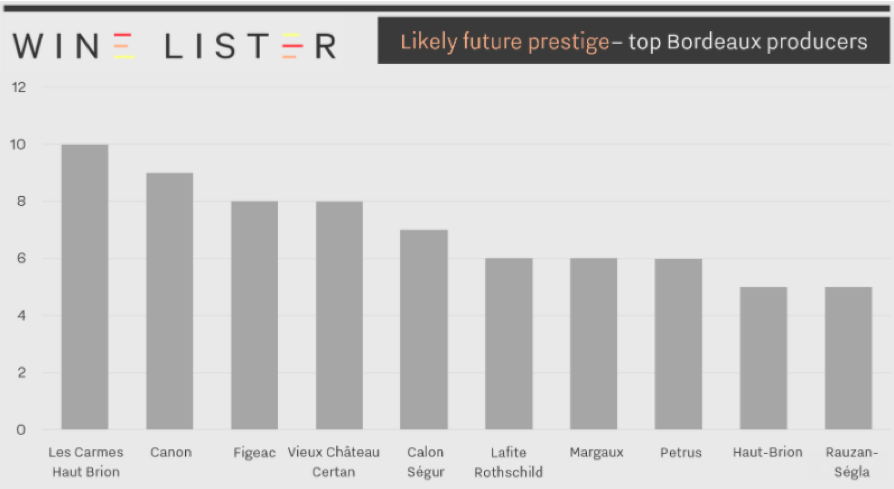 According to Wine Lister’s 2020 trade survey, Haut-Brion is one of top Bordeaux wines most likely to be worth including in collectors’ future cellars.
According to Wine Lister’s 2020 trade survey, Haut-Brion is one of top Bordeaux wines most likely to be worth including in collectors’ future cellars.
Three further pairs of releases from Pessac-Léognan have emerged over the last two days, comprising Malartic-Lagravière, Latour-Martillac, and Carbonnieux.
On Thursday 10th June, Pauillac star-brand Lynch Bages was released, and has resulted in an onward UK selling price of c.£66 per bottle in-bond. Wine Lister’s CEO, Ella Lister, tasted it last week, and found it to be “lifted, precise”, and “a classic”. The price positioning under £70 has reportedly been well-received.
Haut-Batailley was also introduced to the market, at £36 per bottle in-bond. As its second en primeur release under Cazes ownership (the same family as Lynch Bages), the 2019 is 20% under the current market price of the 2018. Following a repositioning of Haut-Batailley’s pricing during en primeur last year, the 2019 release looks good value – the wine’s strong reputation will likely only become stronger with a new wave of investment, and prices are likely to rise accordingly. Lister describes Haut-Batailley 2019 as “pretty”, “elegant”, and “very harmonious”, with a “long, saline, dark chocolate finish” – this is a wine to buy now.
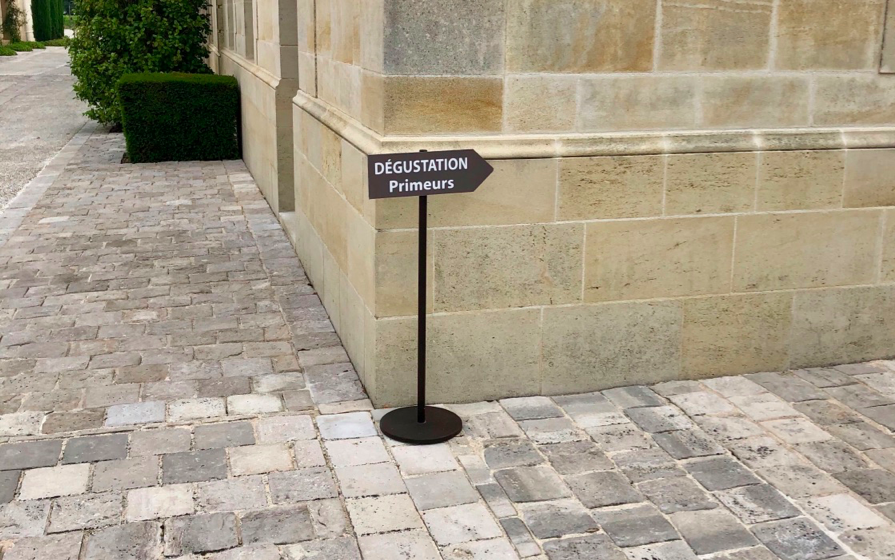 Better late than never – Wine Lister’s CEO, Ella Lister, has now tasted the majority of Bordeaux 2019s. Watch this space for her favourites, and Bordeaux 2019 MUST BUYs coming soon.
Better late than never – Wine Lister’s CEO, Ella Lister, has now tasted the majority of Bordeaux 2019s. Watch this space for her favourites, and Bordeaux 2019 MUST BUYs coming soon.
One further release for each side of the river caught Wine Lister’s eye this week: La Gaffelière 2019 was released 13% beneath the current 2018 market price. The château’s director, Thomas Soubes, told Wine Lister that he was very happy with the quality of their 2019, and Lister concurs – she finds the wine “serious” and “charming”, with “velvet tannin” and “seductive red fruit”. La Gaffelière continues to present excellent value for its impressive quality, relative to wines sharing the Saint-Emilion Grand Cru Classé “B” classification.
Calon Ségur 2019 was also released yesterday. As one of the top rising stars of Bordeaux, its 2019 came onto the market 10% below the 2018 release price, but crucially 31% below 2018’s current market price. Calon Ségur is one of the “poster children” for the true benefits of buying en primeur. Lister found Calon Ségur 2019 to be “perfumed”, “juicy”, and “unctuous”, with “spice on the mid-palate” and a “saline, super-precise finish”. As ever, this is worth snapping up before its price inevitably increases post en primeur release.
Also released during the same period were: Cantenac-Brown, Capbern, Clos Fourtet, Clos René, Cos Labory, Kirwan, Monbousquet, Moulin Saint-Georges, Pavie, Phélan Ségur, Pibran, and Suduiraut.
Keep up to date with further Bordeaux 2019 en primeur releases through Wine Lister’s dedicated en primeur page.
Now into its second full week, the Bordeaux 2019 en primeur campaign shifted up another gear today, with the release of first growth Mouton Rothschild, and its associated properties.
After the flurry of releases yesterday (Monday 8th June) met with very mixed reviews, Mouton reset the campaign tone, with a price 30% below the current market price of 2018, and under the price of all recent back vintages. Bordeaux buyers no doubt breathed a sigh of relief at the tidy figure – £299 per bottle in-bond – the most obvious buy of the campaign so far (other than Lafleur).
Not only is this release on the money in recognising today’s difficult economic context, as well as Bordeaux’s recent price performance struggles, it also provides a brilliant deal given the reported quality of 2019. Wine Lister’s Founder and CEO, Ella Lister found Mouton 2019 to be floral, elegant, and stately. With a high proportion of Cabernet Sauvignon (90%, vs. an average 83%) it promises a long, prosperous life ahead.
Mouton’s younger sibling, also released this morning, looks equally appealing, if for different reasons. Petit Mouton is one of Bordeaux’s top wines for long-term price performance, and its 2019 release price thus manages to enter the market well under all recent back vintages.
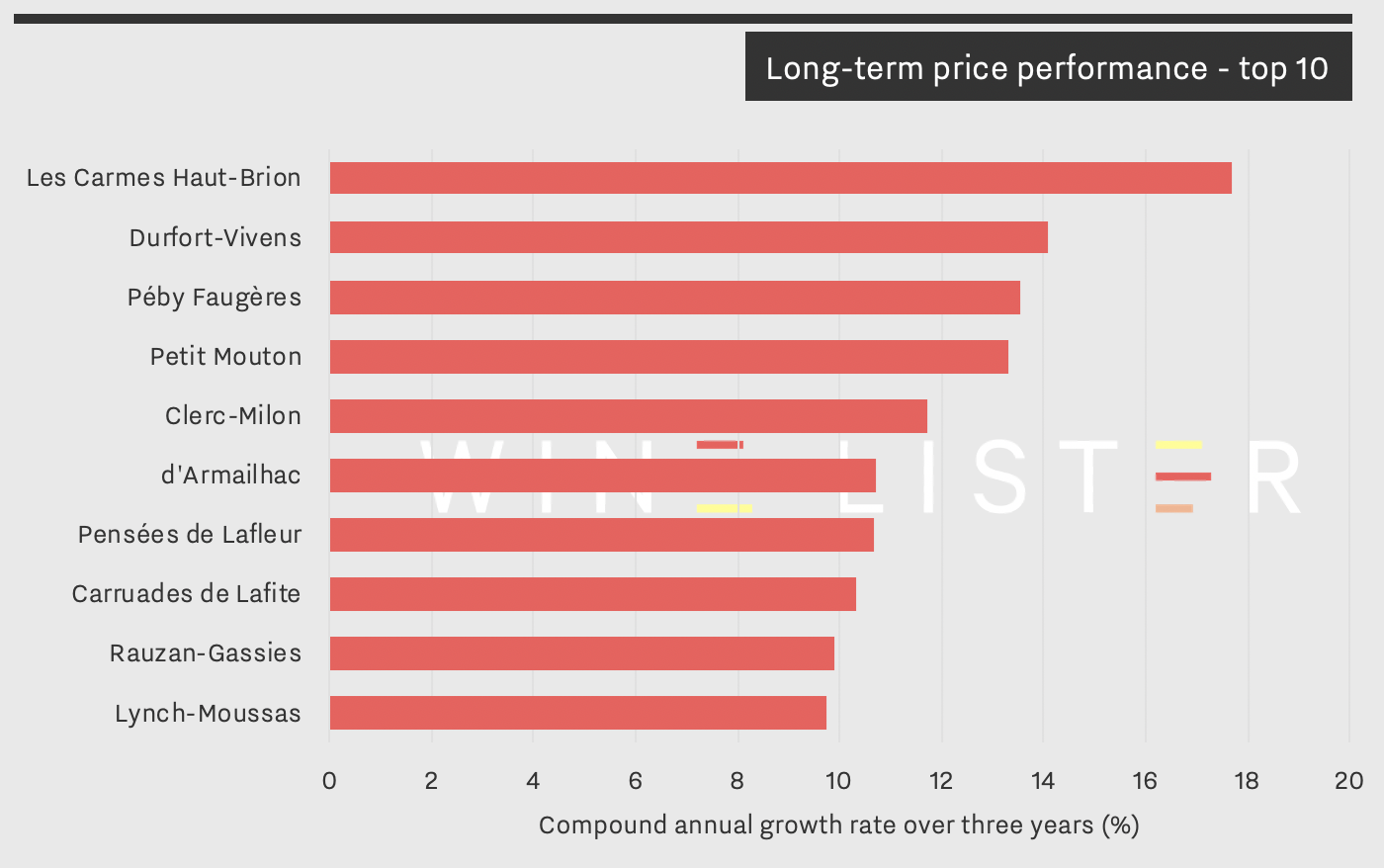 Of major Bordeaux brands, Petit Mouton achieves an average three-year CAGR (compound annual growth rate) of 13.3%, placing it in fourth place of the top 10 long-term price performers, as shown above.
Of major Bordeaux brands, Petit Mouton achieves an average three-year CAGR (compound annual growth rate) of 13.3%, placing it in fourth place of the top 10 long-term price performers, as shown above.
The other 2019s in the Mouton stable, d’Armailhac, Clerc-Milon, and Aile d’Argent were also released today, at prices (per bottle, in-bond) of £31, £52, and £60 respectively.
Yesterday’s hot ticket was right-bank royalty, Cheval Blanc, whose release at £375 also offered consumers a substantial discount on the 2018 release price (32%). Though not yet scored widely by critics, using 2018 as a proxy would mean Cheval Blanc 2019 achieves its joint-highest WL score since the 1961 (alongside the likes of recent greats – 2016, 2015, 2010, 2009, and 2005).
Fellow Saint-Émilion Grand Cru Classé A, Angélus, also released yesterday, though its release price in line with the physically available 2015 perhaps makes it look less attractive. There is nonetheless a real step-change in style and quality happening at Angélus, pioneered by the de Bouärd father-daughter team (Hubert and Stéphanie), which could mean this release is worth investing in for the future.
Two further releases of note from yesterday both hail from Saint-Julien. Branaire-Ducru, a Wine Lister favourite, released its 2019 at £29 per bottle in-bond, 25% down on the 2018 release price. Assuming Branaire’s 2019 is on par with 2018 quality, this is an absolute buy, as the estate’s joint best-ever grand vin at a price beneath all other recent vintages on the market. Léoville-Poyferré 2019 was also released, at £51.34 per bottle in-bond. Offering a 25% discount on last year’s release price for the same quality level, the Saint-Julien second growth is worth considering – having tasted it last week, Lister notes that it is “super-fresh, scented, and luscious”.
Also released so far this week are: Beychevelle, Carillon d’Angélus, Coutet, Gazin, Haut-Bages Libéral, Ferrière, La Gurgue, La Tour Carnet, Larrivet Haut-Brion red and white, and Petit Cheval.
As the first major week of Bordeaux 2019 en primeur releases draws to a close, this morning (Friday 5th June) saw the release of the “first of the Firsts”, and the other reds from the Lafite stable.
Carruades de Lafite 2019 opened the stage with a price of £158 per bottle (in-bond), making it the least expensive Carruades available on the market. The Wine Lister team felt the quality of Carruades saw a significant jump up in 2018, and from what we have heard, the 2019 matches it. With this in mind, and given that volume released onto the market is 50% less than last year, this is a sure buy for anyone seeking access to the Lafite prestige with more approachability.
The grand vin, Lafite 2019, has been released at £426 per bottle in-bond – a discount of c.20% on the 2018’s current market price. The crucial factor this year are the volumes available – also 50% less than last year. On top of this, the single tranche released means buyers will only have one shot to get their hands on the 2019 en primeur (as far as we know). Domaines Baron de Rothschild’s Commercial Director, Jean-Sébastien Philippe, calls Lafite a “modern classic” in 2019, with precision, length, and finesse, but impressive ripeness, making it more approachable than the likes of 2018 or 2016.
Both Lafite and Carruades were cited by the trade as seeing sharp rises in demand (see below) according to Wine Lister’s 2020 Founding Members’ survey. Competition to access both of these wines will therefore likely be high.

Lafite’s Pomerol property, L’Evangile, has released its 2019 grand vin at £146 per bottle in-bond, 15% below the current market price of the 2018. Once again, the Wine Lister team noticed a distinct quality step up in Evangile’s 2018, which we’ve heard has been equalled in 2019. The 2019 reportedly expresses well the move towards a more modern style, and a wine of increasing tension, florality, and freshness, without losing the plush Pomerol profile.
Duhart-Milon 2019 has also been released, at £52 per bottle in-bond. Though the release price puts it more or less in line with market prices of back vintages 2018 and 2016, there is justification to be found in the excellent quality that the Lafite team believe is there in 2019. Philippe explains that Duhart-Milon’s vines sit on a cooler terroir than those of the estate’s Pauillac neighbours, which means in cooler vintages, the wine can be somewhat “austere”. The increasing average temperatures that Bordeaux has seen during recent growing seasons (2018, 2016, and 2015 vintages) therefore only serve to improve the quality of Duhart-Milon, and 2019 certainly had its fair share of heat.
Keep up to date with further Bordeaux 2019 en primeur releases through Wine Lister’s twitter, or through our dedicated en primeur page.
This week has seen a flurry of further 2019 en primeur releases, including the likes of Palmer, Cos d’Estournel, and Domaine de Chevalier’s red and white.
Released this morning (Thursday 4th June) are wines from the Guinaudeau family, including one of the most in-demand wines from Bordeaux, Château Lafleur. Lafleur 2019 is available (for the lucky few who can get their hands on it) for c.£1,550 per 3 pack case in-bond – the same release price as in 2018. While this goes against the 30%-35% discount on last year’s prices that the trade believe may just make the 2019 campaign a success across the board, Lafleur is one of the few exceptions to this rule.
Aside from its impressive and consistent quality, Lafleur boasts one of the smallest-sized estates (4.5ha) for any top Bordeaux property. With rarity on its side, the grand vin is the number one performer for price appreciation after en primeur release.

The chart above shows the top five Bordeaux wines for average percentage increase of the last three vintages – 2018, 2017, and 2016, since their respective releases. The last three releases of Lafleur have seen an average market price increase to date of 43% – 9% more than Petrus.
Perhaps also contributing to the popularity of the Guinaudeau family’s wines is their more “Burgundian” approach to winemaking, with vineyards planted on three separate plots of very different soil types, and the final products aiming to reflect these differences.
For those unable to achieve the dizzy heights of an allocation of the grand vin, the estate’s Perrières de Lafleur (available for £256 per 6-pack in-bond for the just-released 2019 vintage) does exactly this, typically showing mineral, chalky notes from its limestone terroir. Perrières de Lafleur was officially “born” last year, after 15 years of research and testing under the wine’s beta pseudonym, “Acte”.
Finally, at the opposite end of the price spectrum to the flagship wine is Grand Village – the family’s Bordeaux Supérieur, whose quality has come on leaps and bounds over the last few vintages. Grand Village is a Value Pick in every single vintage listed on Wine Lister (2018-2013). If the 2019 is anywhere near the quality of last year, it will surely offer the same impressive quality-to-price ratio.
Follow Bordeaux 2019 en primeur releases through Wine Lister’s twitter, or through our dedicated en primeur page.
We say it every year – the prices have to be “right”. While the Bordeaux 2019 en primeur campaign may be exceptional operationally, the same message resounds from the trade as in many a previous en primeur campaign – the prices have to be right.
Chairman of Farr Vintners, Stephen Browett, defines the crux of the matter succinctly; “one thing that is absolutely crystal clear is that for this en primeur campaign to work, Bordeaux must return to the fundamental (and recently ignored) concept that en primeur wines need to reach the consumer at lower prices than physically available vintages”. For at least the last three Bordeaux en primeur campaigns, release prices have generally been too high. The key difference this year is that the Bordelais have a unique opportunity – COVID-19 and the ensuing global economic crisis – to bring prices down significantly without losing face, or undermining the pricing of previous vintages.
Analysing a basket of 140 top Bordeaux wines, the chart below looks at price movements of the last three vintages on the fine wine market since their respective releases.
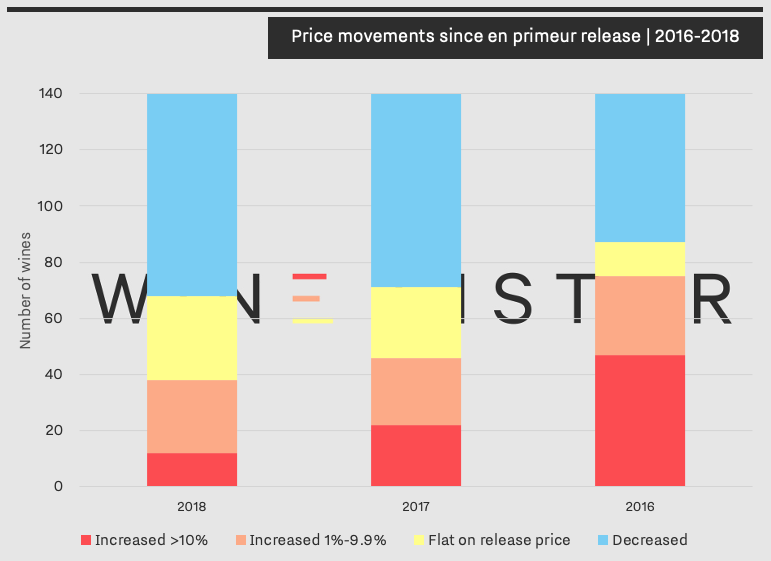
Bordeaux 2016s were released three years ago. As shown in the chart above, today just over half of them are worth more than they were en primeur – these 75 wines have increased by an average of 18% since the spring of 2017, although they include the likes of Les Carmes Haut-Brion, Lafleur, and Petrus, which have seen mammoth price increases of 111%, 109%, and 64% respectively. 65 of the top Bordeaux 2016s have either stayed flat or have decreased in price since en primeur release. Assuming an in-bond storage cost of £12 per case for the last year on these, the chances are that many buyers would have saved more money purchasing 2016s now.
The picture is worse for 2017 and 2018 releases, with approximately half of wines having decreased in value. Last year the high quality of the vintage coupled with small quantities available was cited repeatedly as a reason for price hikes. This year, however, there is no glass door to hide behind. The quality of the 2019 vintage is reportedly excellent, but volumes are also good. Add to this the unprecedented context of a campaign during a global pandemic, and the pressure is on more than ever for prices to drop significantly.
Buying Director of BBR, Max Lalondrelle, tells me, “in order for the consumer to put their faith in the product without knowing too much about the quality or style, the wineries will have to offer some relatively good prices to entice consumers to take the risk”. Members of the trade have elsewhere qualified what “good prices” might mean – a price reduction of 30-35% on 2018s. Flying blind and relying on the historical quality of solid brands to make choices in 2019 (in the absence of all the usual critics scores) is one thing – doing so in the face of such an uncertain future for many is another entirely. For releases to work this year, sacrifices will need to be made by the châteaux – quality of the wine must be put aside, as context, and getting the market to bite during such difficult times, will be everything.
The first major release so far has listened to the market – Pontet-Canet’s 2019 is priced 30% lower than 2018s release. Feedback on the release has been good – Chief Executive of Goedhuis, Tom Stopford Sackville, tells us it was “a very encouraging start to the campaign”, and a “positive signal regarding 2019 pricing in general”. If other châteaux follow suit, the campaign could be a memorable one, that, as Browett puts it, inspires “a new confidence” in en primeur “after recent disappointing campaigns”.
The fine wine trade (Wine Lister included) is rooting for Bordeaux, willing its unique selling system to deliver. The equation for pricing this year could in some ways not be simpler – it is hoped that a sufficient number of properties will take this into account, and present prices the market can embrace.
Releases are set to begin in earnest from tomorrow – 2nd June. Follow them through Wine Lister’s Twitter, or through our dedicated en primeur page.
Chloe Ashton
June 1, 2020
Wine Lister is a big fan of Bordeaux – the city, the people, the wines (of course), and we even have a soft spot for its idiosyncratic system for selling wines. This year has thrown us, as we learn about the 2019 vintage from our desks, confined to our homes, rather than out on the “Médoc highway” or between the walled roads of the right bank.
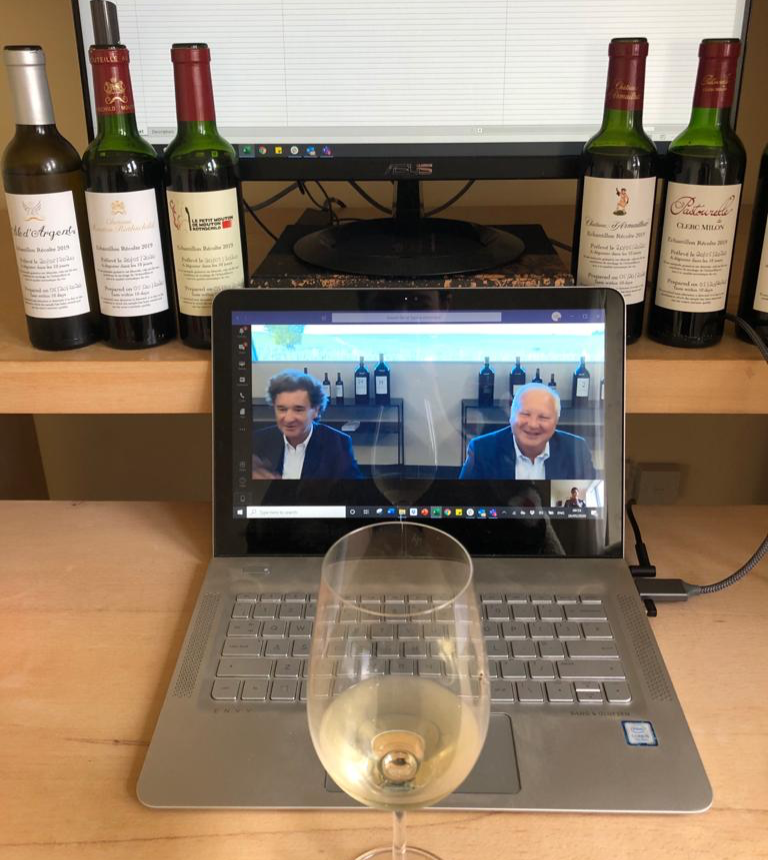 Virtual tasting – Wine Lister’s Founder & CEO, Ella Lister, tastes the Baron Philippe de Rothschild 2019s with Philippe Sereys de Rothschild and Managing Director, Philippe Dhalluin.
Virtual tasting – Wine Lister’s Founder & CEO, Ella Lister, tastes the Baron Philippe de Rothschild 2019s with Philippe Sereys de Rothschild and Managing Director, Philippe Dhalluin.
From what we have heard and read (and from the little we have tasted so far), the 2019 vintage in quality terms is in line with recent greats – 2018, 2015, 2010, and 2009. The current global pandemic makes for an unlucky welcome party for a wine that had luck on its side all through the growing season. Climatic events for the 2019 vintage were far less extreme than for 2018 or 2017. Frost threatened, and heat waves came, but each time the majority of vineyards escaped from disaster. “There was heat, but rain each time we needed it at the precise right moment”, explains Cos d’Estournel’s owner Michel Reybier. He names his Grand Vin in 2019 “miraculous”, and adds that Cos d’Estournel Blanc is the “best white they’ve ever made”. Miracles occurred further south in the Médoc, too – Technical Director Nicolas Glumineau believes that Pichon Comtesse 2019 has finally overtaken the heights of his heretofore “hero wine”, Montrose 2010.
Many producers we have spoken to echo this sentiment, underlining the high quality of the wines made in 2019, and notably, their impressive balance. The best examples in 2019 have reportedly achieved the vinous holy grail: equilibrium between the triumvirate of flavour concentration, structure (from tannin and alcohol), and acidity, thanks in part to the “balanced” weather conditions throughout the growing season.
The winter of 2018-2019 was unusually mild, causing budbreak to occur between five days and two weeks early. While such a phenomenon might normally cause the rest of the season to be premature, including harvest, the vinous clock soon righted itself thanks to a cool spring. Bordeaux spent several nights on frost-alert from late March to mid-May. Véronique Sanders, Director of Haut Bailly tells us they lit fires in the vineyards to protect from frost on at least five occasions during the spring of 2019 – on 27th and 28th March, 13th April, and 5th and 6th May. With no frost damage, and flowering back to “normal” timing, the next challenge facing the 2019 vintage was heat. France’s south-west experienced another hot summer in 2019, but rain arrived just in time on three occasions: one in July, once in August, and then some light showers in early-mid September, bringing freshness and energy to the grapes before harvesting.
Hot and dry spells through the summer have made 2019 a Cabernet Sauvignon vintage; the grape takes up a slightly higher proportion than normal of the blend of many Grands Vins. By the same token, the cooler spells have resulted in good freshness for Merlot. Philippe Dhalluin, Managing Director at Baron Philippe de Rothschild, says that Merlot across the group’s châteaux is the best since 2010, but that the Cabernet Sauvignon is so good, that the high quality of the former will be of benefit largely to the second wines. Mouton Rothschild is made up of 90% Cabernet Sauvignon in 2019, a higher proportion than average.
2019 was lucky in volume, as well as in quality. Dhalluin tells us production volumes of the Baron Philippe stable are normal-to-generous, and he is not alone. On the right bank, Director of La Gaffelière, Thomas Soubes, says “we are lucky to have quality and quantity this year”. Where in 2018 properties across both banks were forced to triage vigorously because of mildew, and started with lower yields due to severe heat stress on the vines, 2019 evaded both of these afflictions. Also contributing to good volumes at many properties were exceedingly healthy grapes at the time of harvest. Director of Talbot, Jean-Michel Laporte explains, “thanks to the impressive health of the grapes, sorting in 2019 was purely about choosing the very best quality”. The first Merlot grapes harvested at Pichon Baron certainly seemed a hopeful sign for the liquid to come.
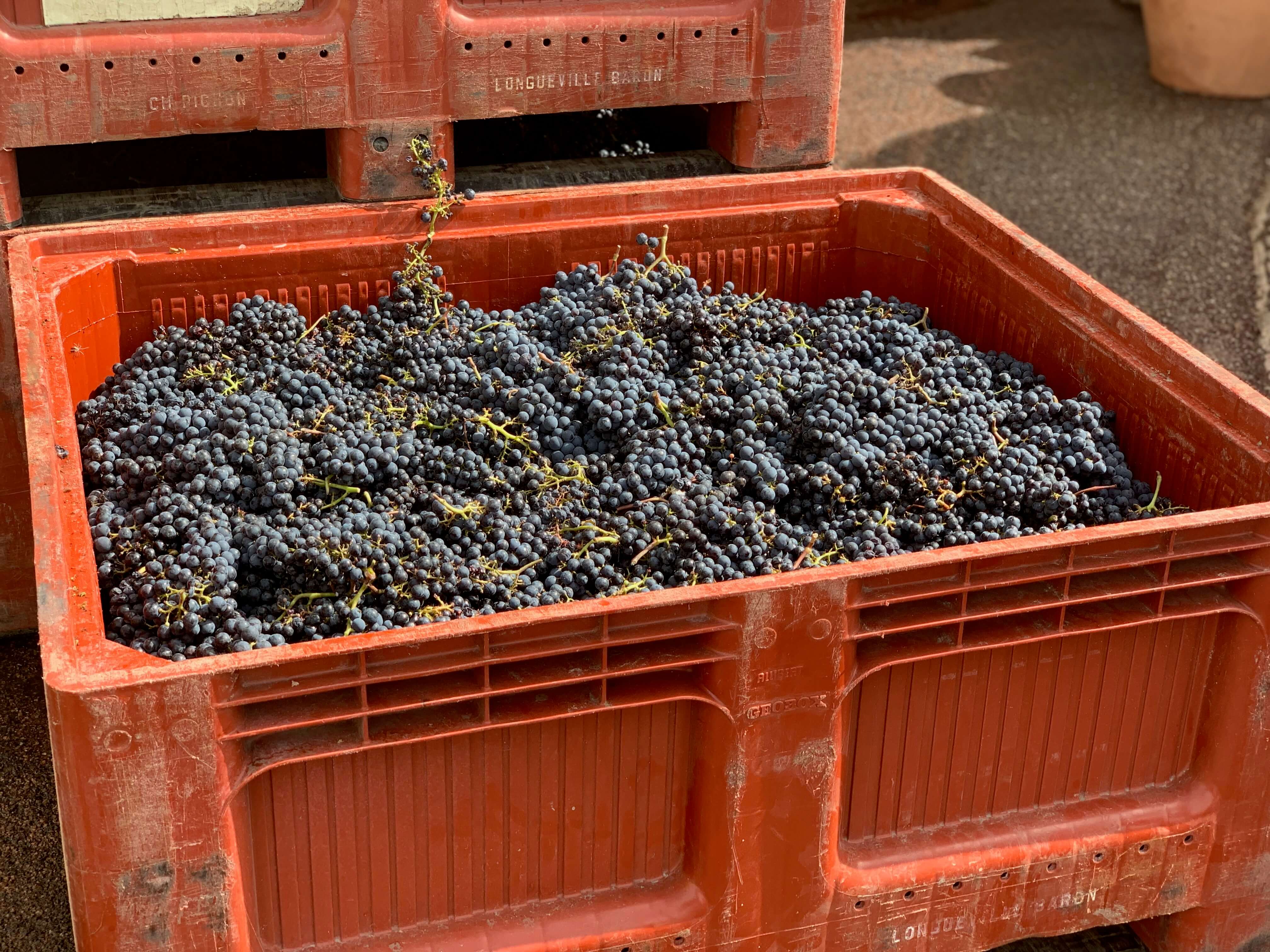 23rd September 2019 – some of the first Merlot grapes to be harvested at Pichon Baron.
23rd September 2019 – some of the first Merlot grapes to be harvested at Pichon Baron.
Though the Wine Lister team is yet to taste the majority of Bordeaux 2019s, their quality appears to be a good news story for a world on lockdown. While the current market could be considered a rather ill-fitting stage for a vintage with such qualitative promise, the releases have just begun (with Pontet-Canet the first major release). Early signs are that the Bordelais are listening, and might just reduce prices in line with the global crisis. For anyone with the headspace for en primeur in the current context, this is a campaign not to be missed.
Wine Lister looks forward to tasting more of the wines as soon as it becomes possible. In the meantime, we will be providing the usual campaign coverage, in the form of real-time release emails for Wine Lister Pro Subscribers, and Twitter alerts for all our followers, as well as live updates on our dedicated en primeur page.
A second post on Bordeaux 2019 will focus on the campaign, and discuss pricing within the unprecedented context of this year’s releases. Watch this space.
As we spare a thought for Bordeaux during what would have been the 2019 en primeur tasting week, we continue to encourage our readers to investigate the abundance of physical vintages available from this noble region. This week we examine the top Bordeaux MUST BUYs in four of the five left bank classified growth groups.
Though the tasting and sale of 2019 may be postponed, 17 reds from last year’s en primeur campaign (2018) still appear in our top MUST BUYs selection, and are worth snapping up for future drinking. The impressive quality of recent physical vintages in Bordeaux, namely 2016 and 2015, is clear to see – each vintage earns 10 and nine MUST BUY places respectively in the Wine Leagues below.
Of the 222 Bordeaux wines that are currently identified as MUST BUYs, 97 are Médoc classified growths. Looking at the top 10 wines for ‘Cru Classé’ levels (second to fifth), WL scores indicate that the quality structure intended in the 1855 classification is perhaps not so rigid, now that modern winemaking techniques have more of an influence. For example, five wines in both the third and fourth growth groups earn 94 WL, and six wines among top fifth growths earn the same score.
These rankings are formulated by Wine Lister’s new interactive tool – Wine Leagues – which can be accessed here.
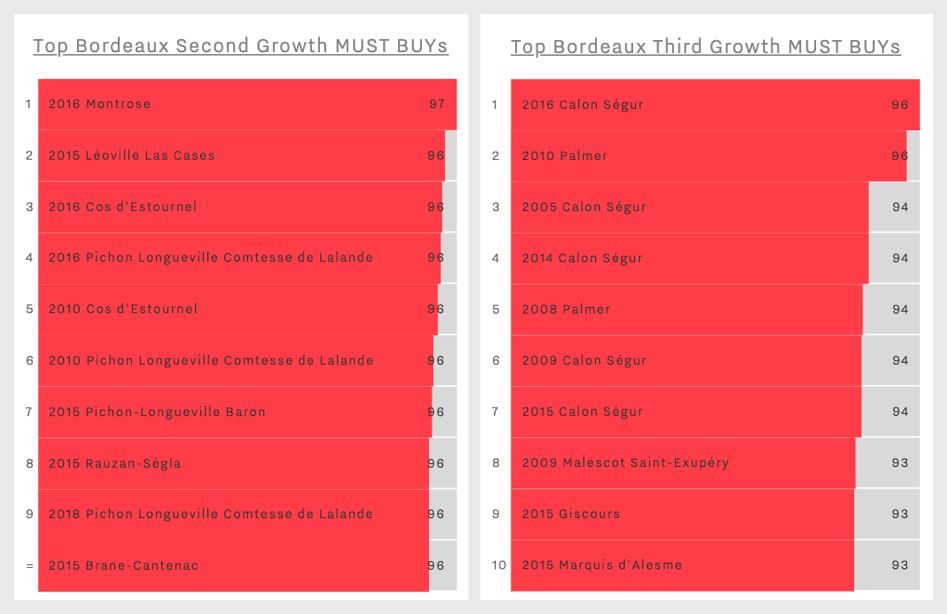
With a WL Score of 97, Montrose’s 2016 release takes the lead spot in the list of top Bordeaux second growth MUST BUYs. Awarded 98 points by Wine Lister partner critic, Antonio Galloni, and described as ‘a wine of pedigree, depth and character’, this wine comes at price of £111 (per bottle, in-bond, when buying by the case). Super-second Pichon Comtesse features three times – with 2016, 2010 and 2018 vintages present. The latter two vintages are available in-bond at Goedhuis & Co – the 2010 would make for a great lockdown indulgence, whilst the 2018 is an investment for future drinking.
Calon Ségur dominates the Bordeaux third growth wine league, occupying half of the top 10 spots with vintages 2005, 2009, 2014, 2015 and 2016. The average cost of these vintages is £71 (per bottle, in-bond). Palmer features twice, though at a higher price – its two listed vintages (2008 and 2010) are available at £204 and £155 respectively from BI Fine Wine & Spirits.
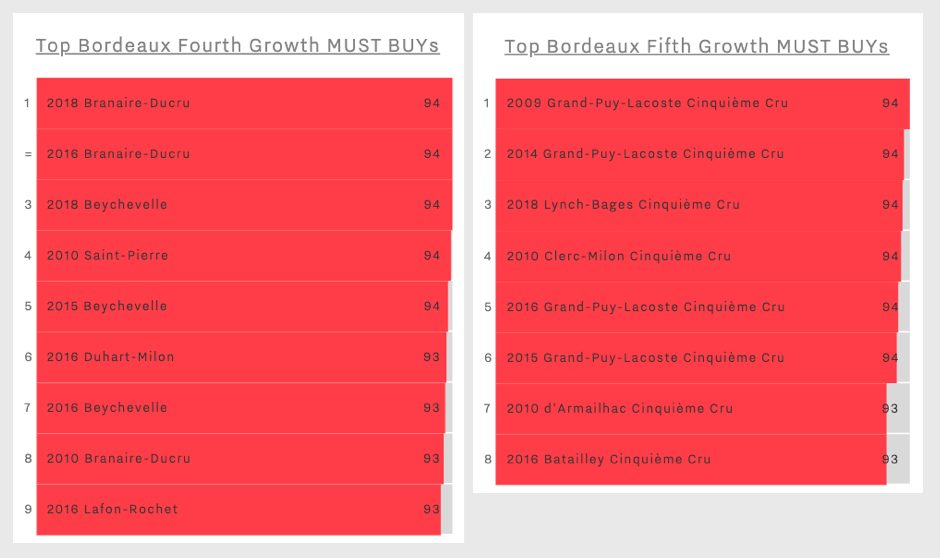
The top Bordeaux fourth growth MUST BUY list is dominated by more recent vintages (2015-2018). Occupying the top two positions with its 2018 and 2016 releases, Branaire-Ducru has a notably good quality-to-price ratio. Both vintages achieve a WL Score of 94 at the cost of £38 per bottle (in-bond). The 2018 Branaire-Ducru achieved special mention in last year’s examination of WL MUST BUYs from Bordeaux en primeur 2018, as did Beychevelle. Both wines are available to purchase by the case (in-bond) at Albany Vintners.
Of the 18 Bordeaux fifth growths, eight achieve MUST BUY status. Grand-Puy-Lacoste achieves multiple entries on the League, with 2009, 2014, 2015 and 2016 all receiving a WL Score of 94. These four deliverable vintages are available from several UK merchants including Berry Bros & Rudd, where prices start from £245 for the 2014 vintage (per case of six in-bond). Described by Neal Martin as ‘one of the great vintages from this estate in the modern era’ the cost of the 2009 supersedes its descendants – a case of six bottles starts at £450 (in bond).
All users can see the standard Wine League page here. Pro users have access to a more extensive set of Leagues, and can log in to access here.
While we would normally be packing our bags in preparation for one of Wine Lister’s favourite weeks of the year, the postponement of this year’s Bordeaux en primeur tasting week comes as a blow for all. Until we can sample the eagerly-awaited 2019 vintage, we can comfort ourselves in self-isolation with the abundance of physical Bordeaux vintages still available for delivery.
In celebration of the brilliant wines that are helping keep Wine Lister’s glasses half-full during the pandemic, this week we focus on some of the best red Bordeaux Value Picks, so that you too can avoid compromising on your quarantine drinking preferences without breaking the bank.
Wine Lister’s Value Pick score is calculated based on the quality-to-price ratio of a wine and vintage, as informed by price data and reviews from our partner critics. See the image below for five of our top Bordeaux Value Picks over the past four vintages.
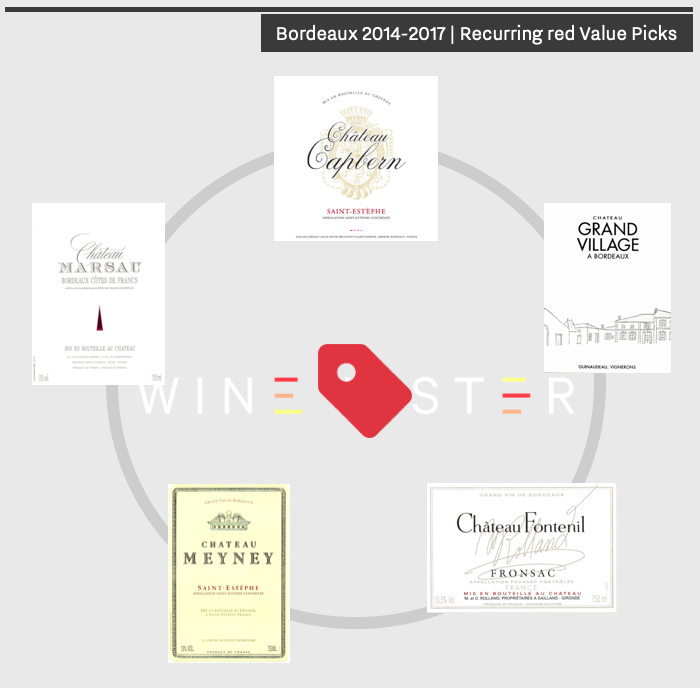
- Château Capbern
Capbern obtains an average Value Pick score of 35 across the last four deliverable Bordeaux vintages, and offers excellent value for money. This Saint-Estèphe château is the sister property of Calon-Ségur. Described by one of our partner critics, Jancis Robinson, as a ‘veritable steal’, the 2014 vintage ‘continues to look exceptionally good and still fully deserving of its score of 17 en primeur’. The 2016 vintage achieves Capbern’s highest WL Value Pick score (36.2) of the four vintages, and we highly recommend getting your hands on some, available by the dozen in-bond starting from £200, from UK merchants including Farr Vintners and FINE+RARE. Millésima USA and Millésima HK also deliver this brilliant wine.
- Château Grand Village
Achieving Value Pick status for three of the four vintages examined (2017, 2016, 2015), Grand Village exhibits a dependably high quality-to-price ratio. As the original Bordeaux home of the Guinaudeau family – the producers of Lafleur – Grand Village is the accessible answer to the same exceptionally high winemaking standards applied to its parent wine. Its classification as a Bordeaux Supérieur plays a part in its inherently reasonable price (c.£13 per bottle in-bond, when buying by the case). Grand Village’s 2017 vintage achieves the highest Value Pick score (38) of all five wines and four vintages here mentioned, and is available for delivery from the Guinaudeau family wines’ UK agent, Justerini & Brooks.
- Château Fontenil
A second Value Pick from an ‘outlying’ Bordeaux appellation, Fontenil’s 8.5-ha vineyard is located at the highest elevation on the plateau of Fronsac. As renowned flying winemaker, Michel Rolland’s ‘passion project’, he purchased the site with his wife, Dany, in 1986 with the intention of inhabiting the house that was situated on its land. Taking on the responsibility of attending to the vines that came with it, and creating an entirely new estate, Fontenil is now a boutique wine of excellent quality at an average cost of c.£20 per bottle in-bond. Given its small production volume, Fontenil is not as easy to find as our other four Value Picks, however, in the UK, Laithwaites is the place to buy (as soon as they reopen their website for orders – they are currently experiencing an overload of demand due to lockdown buying).
- Château Meyney
Located in the east of Saint-Estèphe, the plots of this Cru Bourgeois are situated next to Montrose. Long considered a wine trade darling for its impressive value, Meyney continues to achieve high WL scores. Its 2015 vintage received particular praise from our partner critics, with Neal Martin describing it as ‘blowing everyone’s expectations, including his own‘. With prices starting at £25 per bottle in-bond, you can order this wine through Goedhuis in the UK, where a case of 6 bottles stands at £200, including VAT. If you are in the USA, you can place your order with Millésima.
- Château Marsau
Like Meyney, Marsau’s 2014 and 2015 vintages are Wine Lister Value Picks. The 2016 is too, and though the wine seems to get better every year, the latter may need a touch more time in bottle before drinking. Marsau is run by Anne-Laurence and Mathieu Chadronnier (Managing Director of the Bordeaux négociant, CVBG). The Marsau vineyards feature 85% Merlot planted on predominantly clay soils, resulting in a classically right-bank wine with soft, round fruit and great balance. The 2014 vintage represents particularly good value – priced at £20 for the bottle in-bond, with a high Value Pick score of 35. The UK-based merchant BI Wines is delivering this vintage, whilst those on the other side of the pond can place their order with JJ Buckley Fine Wines.
You can identify good value in further back vintages of any of the above-mentioned wines by using the Vintage Value Identifier on each wine page. See the example for Meyney below or by clicking through to its wine page here.
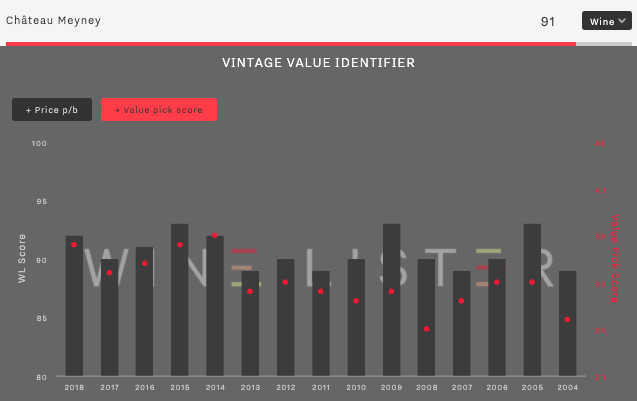
A new “normal” seems to be developing for Bordeaux.
After a fleeting trip around Bordeaux properties on both banks at the start of harvest, the Wine Lister team is excited to see the 2019 vintage take shape.
We must admit this was not our sentiment on the 23rd September, when, on arrival in a dreary, damp Bordeaux, our first thought went to the poor pickers, and of course to the grapes and potential spread of disease in such wet conditions.
Thankfully this worry was quickly cast aside – “the grapes are in an incredibly healthy state. For grape health, this has been a dream year”, said Château Dassault’s Valérie Befve. This, she further explained, was thanks to the combination of a good spring without too much humidity, budburst that was a little cold but without rain, and a dry summer that was hot without having placed too much water stress on the majority of the vines.
The summer heat wave and consequential drought, similar in timing and nature to 2018 (and to an extent, 2016), will likely result in another year where freshness and caution in extraction are key. Befve put this succinctly, noting that the “skin to juice ratio will require delicate management”. This theme, recurring in several of the last Bordeaux vintages, highlights the importance of careful handling in the cellars, and explains in part the purposeful movement towards a fresher, more approachable style, and away from big tannins and high alcohol that need time in bottle to soften.
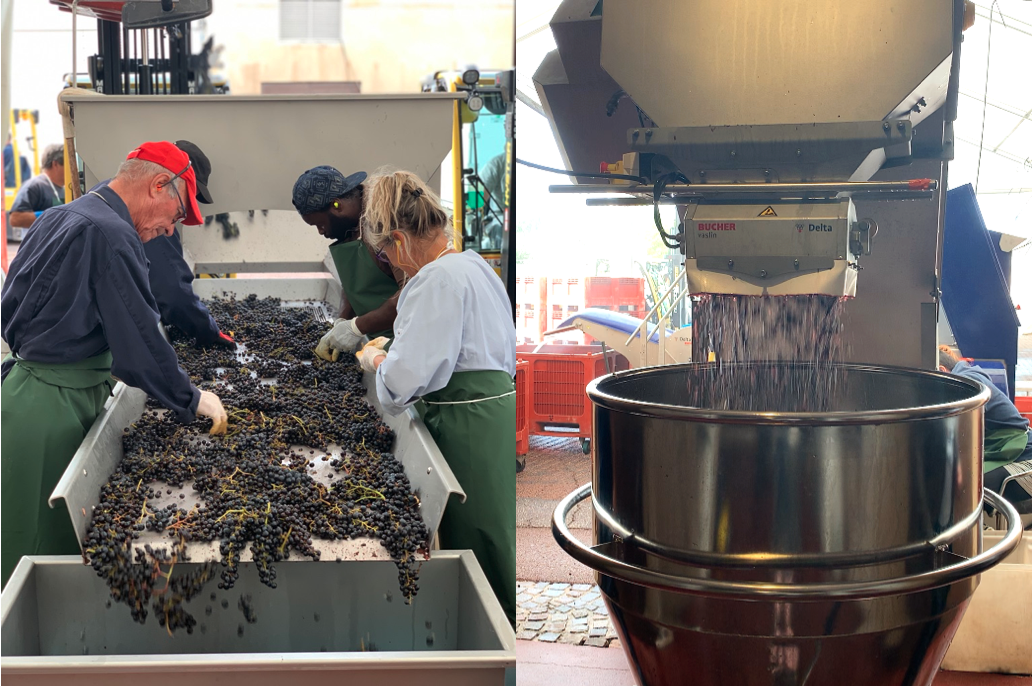
Left: Sorting of the first Merlot grapes at Pichon Baron. Right: Pichon Baron now uses small vats on wheels to transport freshly-picked grapes into fermentation tanks, since they cause less breakage of grape skins than traditional pumps.
Comparable characteristics seem in play on the left bank too. At Pichon Baron we tasted some of the very first 2019 Merlot grapes, and though the berries are a little smaller than usual (because of the drought), they are in perfect health. Axa Millésimes’ Commercial Director Xavier Sanchez was quick to say that it was far too soon to speculate on quality levels, but that the very early analyses “resembled 2018 and 2016”.
Grapes of high sugar content will need to be vinified with caution in order to balance potentially high alcohol levels. The rain that has fallen in the past 10 days will likely be a welcome gift to the Cabernet Sauvignon from the “grands terroirs” on this front, the majority of which are set to be picked this week.
Sara Lecompte Cuvelier, Managing Director of Léoville Poyferré and Le Crock echoed the positive sentiment on the general quality of grapes for both her properties, in Saint-Julien as in Saint-Estèphe – “We’re hopeful it will be another beautiful vintage, for both quantity and quality this year”.
While successions of good years are by no means unusual for the bordelais, harvests following heatwaves are becoming a pattern. All that remains to be seen is how the winemakers of Bordeaux deal with this “new normal” in the cellar. We are looking forward to finding out next year!
Wine Lister spent a week in Bordeaux tasting the 2018 vintage in April, and has dedicated the last two months to covering en primeur releases for its Pro Subscribers. After what has been an unpredictable and puzzling Bordeaux en primeur campaign, we have conducted more than 20 interviews with our Pro Subscribers and Founding Members to find out how it went for them.
Below you will find our conclusions on the Bordeaux 2018 en primeur campaign, which combine our own intimate knowledge of the campaign and its peculiarities with invaluable insights from the trade.
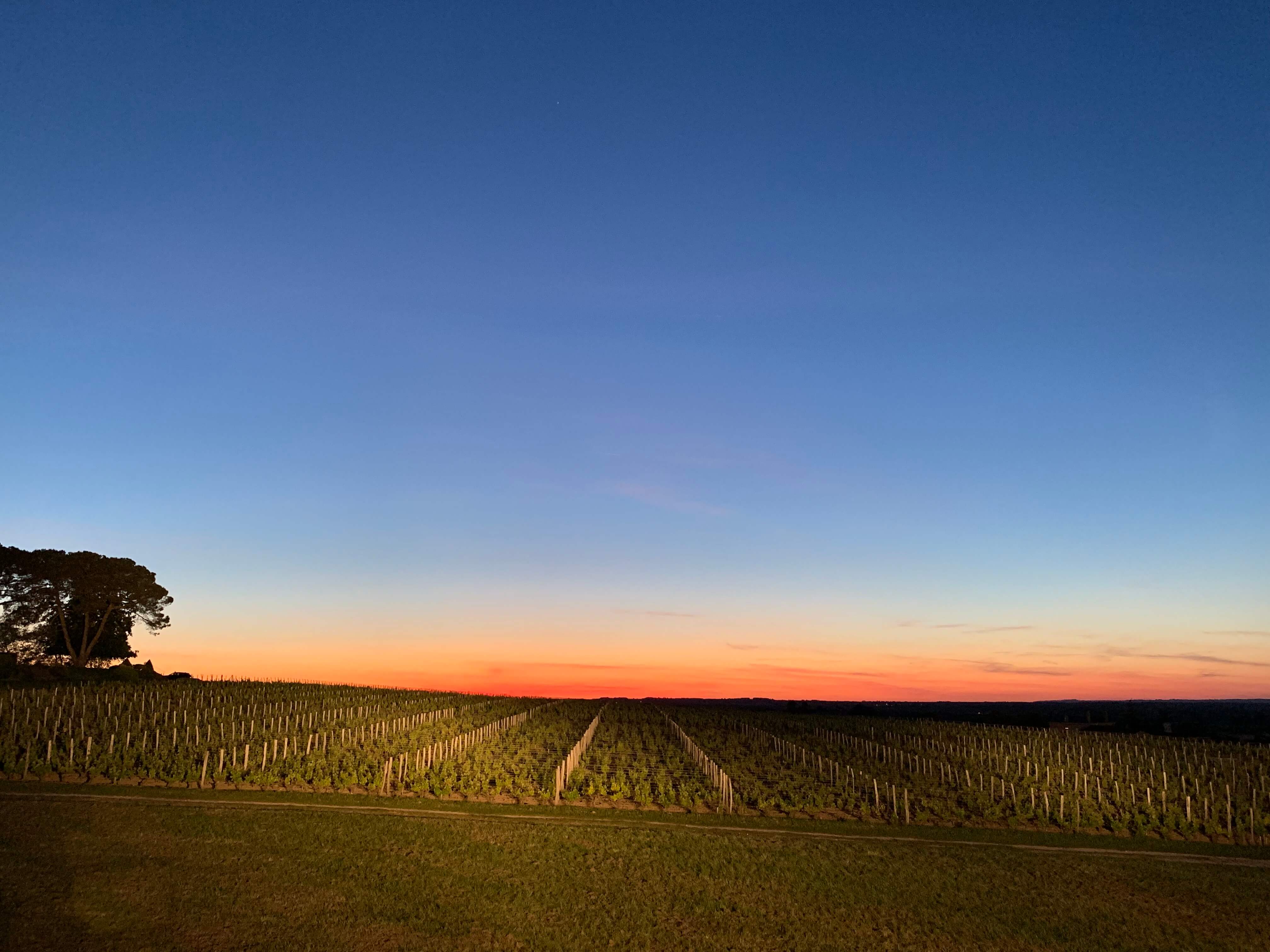
Timing
The campaign lasted 62 days compared to 59 last year (from the date of the first major release to the last standard-channel releases). One clear improvement, thanks to a concerted effort by courtiers, was the spacing out of releases more evenly over the period. However, this did not address the more acute concern around the overall length of the campaign, with the wine trade expected to concentrate on the new Bordeaux vintage for two whole months of the year.
Pricing
A more major frustration was pricing. Over 80% of Wine Lister Pro Subscribers / Founding Members surveyed said prices were too high. On average, prices were up 13% on 2017 and 2% on 2016 release prices. This only made sense where 2016s had gone up in the market since release – not often enough the case. As a result, 2018s came onto the market on average 1% above the current market price of 2016, despite the latter – one of the vintages of the century – being physically available.
Needless to say, many wines stalled upon release due to over-ambitious pricing. When we asked the trade which wines sold the worst, more than once the reply was, “too many to mention”.
Desire
However, one of the more unfathomable motifs of the campaign was that in several instances, this highly ambitious pricing was accepted by the market, and the wines sold through. These were wines with good momentum behind them and a particularly loyal following, but most of all they were wines with a specific story that superseded any thought of value relative to prior vintages.
Examples of this phenomenon are Domaine de Chevalier and Palmer. Both were released into the market above every recent back vintage, and yet both met with demand thanks to the stories behind each wine. Domaine de Chevalier’s owner, Olivier Bernard, started sowing the seed several months before the campaign saying his 2018 was the best wine he’d ever made, a statement reiterated by the rest of his family and gradually absorbed through the fine wine chain. Unable to use conventional sprays, Palmer lost two-thirds of its crop to mildew, and made a striking, unusual wine that Managing Director Thomas Duroux said would “go down in history”.
“The market is very smart and only follows brands that it’s imperative to buy en primeur,” states Laurent Bonnet, Export Director of négociant L.D. Vins.
It was a campaign that favoured top names, not value wines. Wines below €50 were largely unsuccessful (with a few exceptions such as Laroque, Capbern, and Potensac – the three most affordable Bordeaux 2018 Wine Lister MUST BUYs).
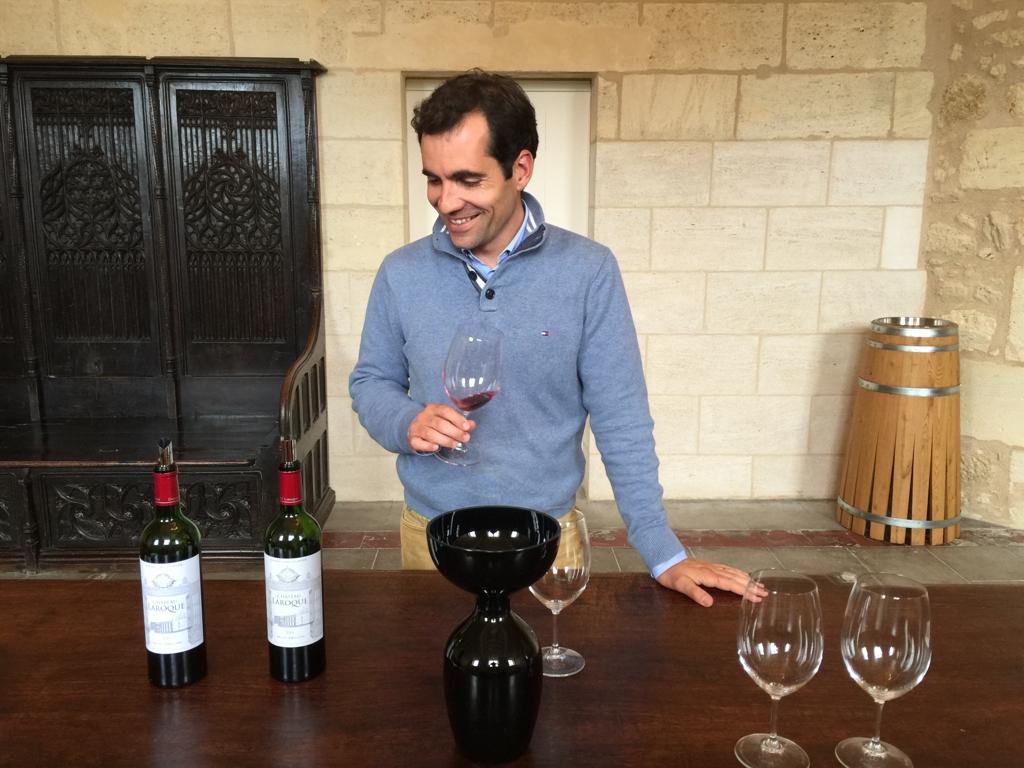
David Suire, Managing Director of Château Laroque – a Bordeaux 2018 WL MUST BUY
Volume
After pricing, the most cited frustration was reduced volumes. On average, leading properties released around 20% less wine than last year. “The number one cause of reduced volumes is lower production in 2018 compared to previous years,” said Mathieu Chadronnier, Managing Director of négociant CVBG, who, like other participants in the campaign would have liked to have more volume to sell of certain wines. “It is a frustration, but there’s nothing we can do about it,” he concluded.
Certainly several properties produced less wine due to mildew and a very dry summer. Others made a commercial decision to keep back more wine – a continuation of the gradual trend for Bordeaux châteaux to release less wine en primeur, whether to create an impression of rarity, and / or to partake in the future upside by selling the bottled wine later once it has – they hope – increased in value.
Bonnet underlines the irony of having less and less stock of the wines that sell well, and too much of those that don’t: “The ‘not enough of in-demand wines / too many wines to hold as stock’ equation is difficult for négociants to resolve,” says Bonnet, cautioning that, “the financial stakes are high.”
Good news stories
While Asian buyers were reported to be less present than in previous years, other geographies remained strong – the US, continental Europe, and especially the UK.
The 10 greatest success stories of the campaign included six Wine Lister MUST BUYs: Calon Ségur, Canon, Carmes Haut-Brion, Rauzan-Ségla, Léoville Las Cases, Mouton Rothschild, and Lynch-Bages.
Revenues were up on 2017 across the board, in many cases very significantly. The majority of respondents reported en primeur revenues the same as or above 2015 levels, with only a couple of exceptions. However, very few managed to equal 2016 revenues.
Future(s)
On the one hand, it seems obvious that the 2018 Bordeaux en primeur campaign could have been more of a roaring success with more astute pricing and in some cases a bit more volume to go around. On the other, many of our Pro Subscribers and Founding Members have been pleasantly surprised by the outcome, and will conclude their campaigns with better revenues than they expected.
This leaves many convinced of the merits of en primeur, if frustrated that it’s not reaching its full potential. “We could have done £35m,” said Max Lalondrelle, Fine Wine Buying Director of UK merchant Berry Bros. & Rudd, which in fact made c.£22m in revenues on the 2018 Bordeaux en primeur campaign.
Meanwhile other members of the trade have ceased their Bordeaux en primeur activity altogether over recent years, and some are questioning its future viability. For the time being, the sun has set on this year’s campaign, but it will rise again next year on the utterly unique global marketing and distribution tool that is en primeur.
Read more about our new MUST BUY tool in our recent blog here.
 According to Wine Lister’s 2020 trade survey, Haut-Brion is one of top Bordeaux wines most likely to be worth including in collectors’ future cellars.
According to Wine Lister’s 2020 trade survey, Haut-Brion is one of top Bordeaux wines most likely to be worth including in collectors’ future cellars. Better late than never – Wine Lister’s CEO, Ella Lister, has now tasted the majority of Bordeaux 2019s. Watch this space for her favourites, and Bordeaux 2019 MUST BUYs coming soon.
Better late than never – Wine Lister’s CEO, Ella Lister, has now tasted the majority of Bordeaux 2019s. Watch this space for her favourites, and Bordeaux 2019 MUST BUYs coming soon. Of major Bordeaux brands, Petit Mouton achieves an average three-year CAGR (compound annual growth rate) of 13.3%, placing it in fourth place of the top 10 long-term price performers, as shown above.
Of major Bordeaux brands, Petit Mouton achieves an average three-year CAGR (compound annual growth rate) of 13.3%, placing it in fourth place of the top 10 long-term price performers, as shown above.


 Virtual tasting – Wine Lister’s Founder & CEO, Ella Lister, tastes the Baron Philippe de Rothschild 2019s with Philippe Sereys de Rothschild and Managing Director, Philippe Dhalluin.
Virtual tasting – Wine Lister’s Founder & CEO, Ella Lister, tastes the Baron Philippe de Rothschild 2019s with Philippe Sereys de Rothschild and Managing Director, Philippe Dhalluin. 23rd September 2019 – some of the first Merlot grapes to be harvested at Pichon Baron.
23rd September 2019 – some of the first Merlot grapes to be harvested at Pichon Baron.





